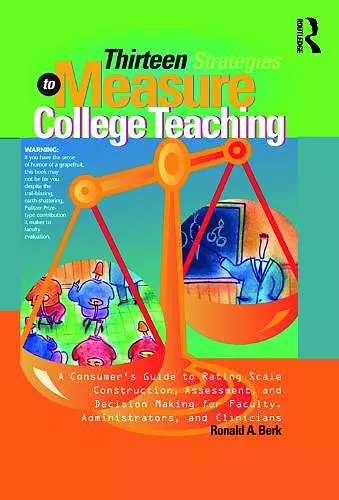Thirteen Strategies to Measure College Teaching
A Consumer’s Guide to Rating Scale Construction, Assessment, and Decision-Making for Faculty, Administrators, and Clinicians
Format:Paperback
Publisher:Taylor & Francis Inc
Published:5th May '06
Currently unavailable, and unfortunately no date known when it will be back

* Student evaluations of college teachers: perhaps the most contentious issue on campus* This book offers a more balanced approach* Evaluation affects pay, promotion and tenure, so of intense interest to all faculty* Major academic marketing and publicity* Combines original research with Berk’s signature wacky humorTo many college professors the words "student evaluations" trigger mental images of the shower scene from Psycho, with those bloodcurdling screams. They’re thinking: "Why not just whack me now, rather than wait to see those ratings again." This book takes off from the premise that student ratings are a necessary, but not sufficient source of evidence for measuring teaching effectiveness. It is a fun-filled--but solidly evidence-based--romp through more than a dozen other methods that include measurement by self, peers, outside experts, alumni, administrators, employers, and even aliens. As the major stakeholders in this process, both faculty AND administrators, plus clinicians who teach in schools of medicine, nursing, and the allied health fields, need to be involved in writing, adapting, evaluating, or buying items to create the various scales to measure teaching performance. This is the first basic introduction in the faculty evaluation literature to take you step-by-step through the process to develop these tools, interpret their scores, and make decisions about teaching improvement, annual contract renewal/dismissal, merit pay, promotion, and tenure. It explains how to create appropriate, high quality items and detect those that can introduce bias and unfairness into the results.Ron Berk also stresses the need for “triangulation”--the use of multiple, complementary methods--to provide the properly balanced, comprehensive and fair assessment of teaching that is the benchmark of employment decision making.This is a must-read to empower faculty, administrators, and clinicians to use appropriate evidence to make decisions accurately, reliably, and fairly. Don’t trample each other in your stampede to snag a copy of this book!
"The humor is delightful and the information critical to understanding the process of evaluating assessment instruments. The University of North Texas has formed a committee to examine student evaluation forms as a first step to help measure overall teacher effectiveness. I have recommended that the other members purchase a copy."
Paula Iaeger, GSA in the Office of the Provost and VP for Academic Affairs
“The evaluation of teaching is something that is done virtually wherever teaching itself is done. At too many places, though, it is done in a shallow, haphazard fashion.
Ron Berk’s book aims at evangelizing the rest of academia with the good news of how to do it right. This is ground that other well-respected academics have covered, but perhaps none aimed quite as much at the average faculty member. Berk does an excellent job at directing the reader to the relevant work that has been done in the field. The book is laid out in a logical fashion, with an introduction that describes the motivation for the book, followed by a chapter summarizing the thirteen strategies (i.e. sources of evidence used for evaluating teaching). This chapter gives an excellent overview of what Berk calls 360° Multisource Assessment, which is another way of saying that you should take many sources of evidence into consideration when assessing college teaching. This chapter is a good overview of building a teaching evaluation system, and can be read as a stand-alone topic. The book’s subtitle is actually a much better description of the main point of the book. For those faculty members or administrators who have been tasked with the development or overhaul of such a system at their college, the overview chapter may be the only one that is needed. For those who must develop student evaluation forms and other ratings instruments, the rest of the book contains invaluable information. Berk provides a step-by-step procedure for determining how the rating scales should be constructed, what questions (items) should asked, and what type of anchors (response choices) is appropriate. He provides examples of rating scales and items, both good and bad. Very importantly, he also provides clear instructions on how to field test the rating scale and how to determine its validity and reliability.”
International Journal for the Scholarship of Teaching and Learning
“Berk’s list of strategies is (as advertised) one of the most complete discussions of these issues. This book can be used by both novices and experienced practitioners as a guide to better practice. That’s why it is worth reading."
from the Foreword by Michael Theall, Associate Professor, Education, & Director, Center for the Advancement of Teaching And Learning at Youngstown State
ISBN: 9781579221935
Dimensions: unknown
Weight: 439g
288 pages